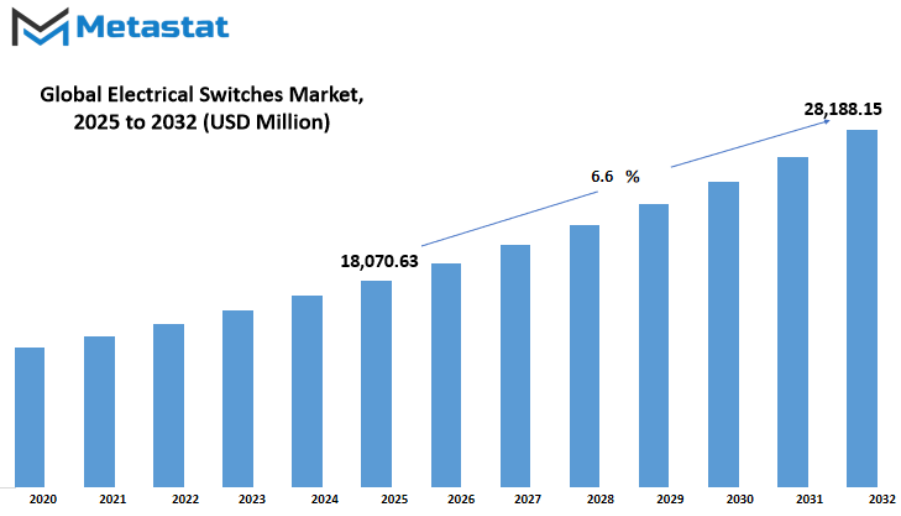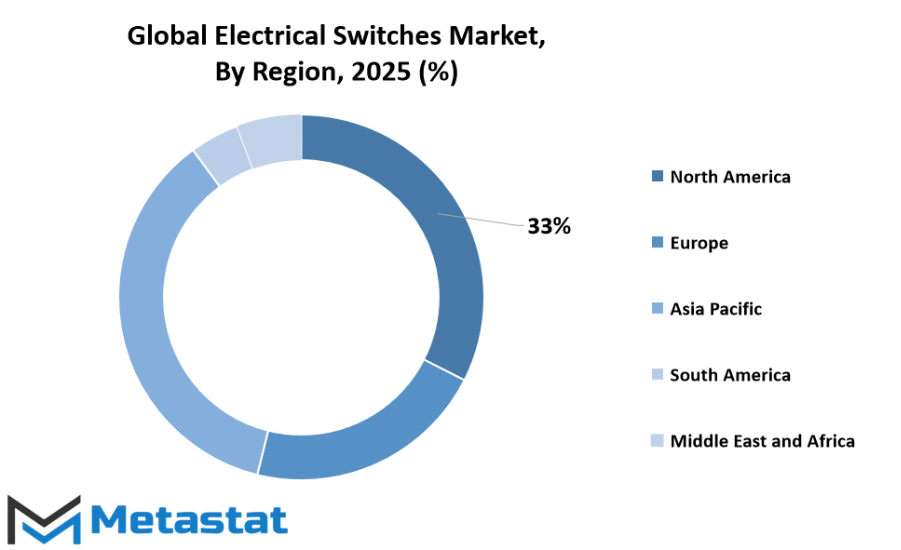MARKET OVERVIEW
The global electrical switches market will be characterized by something beyond the physical motion of switching power on and off. Outside of the narrow definition, this market will become a cornerstone of intelligent infrastructure, closing the gap between mechanical functionality and digital intelligence. As the world moves toward more integrated systems, the business will not be limited to producing and selling switches but will also venture into the development of interactive, response solutions that evolve to suit residential and industrial environments. Future development will be driven by need for safer, smarter, and better looks-integrated devices, putting switches in the foreground of human interaction with technology.
In the coming years, business will not be held back by the simple role of flow control of electricity. Electrical switches will bear the responsibility of energy efficiency, user experience, and improved safety features. These factors will take the global electrical switches market from being viewed as a commodity to being seen as a technology-based requirement. As energy networks become increasingly sophisticated, switches will also become active players in maximizing the use of power, enabling them to become crucial tools of sustainability and conservation. The general consequence of this transition will be that the market is no longer about basic components but orchestrating smart networks in today's settings.
The growth of this market will also be influenced by how well it can integrate with the design concepts of both residences and offices. Buyers will anticipate that electrical switches will integrate with interior design in a very seamless manner, resulting in demand for products that will balance looks and high-level functionality. This convergence of technology and design will create new standards for the sector, with innovation not just in engineering but spreading to lifestyle integration. Switches will be created to suit contemporary living, which implies they will possess both utilitarian importance and cultural significance.
Industrial uses will broaden the size of the global electrical switches market even further. With automation and sophisticated machinery characterizing manufacturing processes, switches will cease to be peripheral devices but rather embedded control units that add reliability to operations. Their incorporation into factory installations, data centers, and public infrastructure will place them in the spotlight as key components of large-scale systems. These technologies will place the industry on a trajectory where switches are viewed as facilitators of productivity and not back-end components.
Beyond the traditional story, the global electrical switches market will frame the conversation of how people engage with power systems. Its expansion will echo a wider shift in the manner in which energy is consumed, regulated, and personalized. The sector will go geography and area limitations, turning into intertwined with the digital and bodily worlds of present day society. Though the transfer would possibly look plain in look, its destiny might be a complicated amalgamation of safety, innovation, and cultural significance, making it one of the quiet but riding forces in the back of technological advancement.
Global electrical switches market is estimated to reach $28,188.15 Million by 2032; growing at a CAGR of 6.6% from 2025 to 2032.

GROWTH FACTORS
The global electrical switches market will remain in the limelight as technology and consumer trends shift towards smarter and more efficient solutions. Electrical switches, which were traditionally considered simple household or industrial fittings, are now gaining more sophisticated designs with the quick uptake of digital and automated solutions. Smart home solutions are one of the strongest drivers behind this market. Individuals are increasingly in search of convenience, energy savings, and protection in their homes, and smart switches are in the middle of making that happen. The switches enable users to manage lights, devices, and even entire energy systems from a distance, opening the potential for homes and businesses to control their usage more accurately.
A further influence on the market is the constant expansion of building and infrastructure development globally. With accelerated urbanization and development investments in residential, commercial, and industrial structures, the demand for dependable electrical components is growing. Contemporary building trends are not only about function but also sustainability and smart automation, and connected electrical switches are witnessing increased demand. As cities become smarter and infrastructure becomes more connected digitally, these switches will no longer be viewed as a luxury but a requirement.
In the face of all these positive forces, there are challenges that may limit market advancement. The exorbitant price of smart switches remains an obstacle in most countries, particularly in areas where customers are sensitive to prices. Concurrently, the threat of counterfeits is a concern. These poor-quality versions tend to chip away at the confidence of customers and, in addition, create threats to their safety. The manufacturers and regulators alike will have to tackle these issues so that innovation is not hindered by affordability issues or quality issues.
In the future, the global electrical switches market will gain from the increasing use of IoT-enabled devices. More appliances, security systems, and lighting solutions are being made with the ability to be connected to digital platforms, meaning the smart switch role will grow even larger. They shall be key points in building glitch-free automation experiences for homes and industries alike. Such a meeting of convenience, technology, and connectivity bodes well for the future, where electrical switches, besides controlling power, shall be helping make living and working more intelligent.
MARKET SEGMENTATION
By Type
The global electrical switches market will remain an integral part of contemporary technology, its significance going far beyond mere on-and-off functions. Electrical switches provide the initial interface point between humans and millions of machines, devices, and systems, influencing convenience, security, and control in industries, homes, and transport. With innovation advancing, switches will no longer be basic mechanical parts but will have more smart features in them, enabling them to learn and change according to automation, hardness requirements, and manufacturers' and users' design needs. This constant integration will make them an indispensable component of the future of interconnected technology.
In this industry, product types form a diversified base of applications. Push Button Switches by themselves are well worth $5,607.62 million, indicating how much they are used in commercial and customer merchandise. They have proved to be reliable and simple to use, making them the cross-to switches on top of things panels, equipment, and domestic appliances. Toggle Switches, Push Wheel Switches, and Keylock Switches will persist in pleasing specialized capabilities wherein durability, exacting function, or safety matters. Every category is a response to a distinctive requirement, now not permitting the marketplace to be dependent on someone transfer design but on a selection that as a set helps its growth.
Preference in layout is but every other issue that influences call for Rocker Switches, Snap Action Switches, and Tactile Switches. Rocker Switches are maximum usually seen in purchaser electronics and home appliances, wherein simplicity of use and small size rely. Snap Action Switches are in demand where velocity and accuracy are needed, at the same time as the responsive remarks of Tactile Switches has made them a vital element in patron products together with keyboards, vehicle controls, and handheld devices. These styles of switches emphasize how switches, further, to being realistic, are also related with the person's experience and for this reason have a special area in business and purchaser markets alike.
The "Other Types" category also indicates that innovation will not be limited to the conventional types of switches. New designs will be for specialized markets, medical equipment, or intelligent systems where adaptability and customization are essential. These changing needs will continue to keep the market open for new opportunities, and hence electrical switches will be an integral part even as automation and wireless technologies continue to expand. The global electrical switches market thus not only stands as an industry founded upon mechanical action, but one that will expand and grow through adaptability, usability, and diversity of product range.
By State
The global electrical switches market is gradually gaining popularity as it finds extensive use in both residential and industrial sectors. Apart from being required for basic electrical control, the switches are also being incorporated for more sophisticated uses in contemporary environments. As concern for efficiency and safety increases, producers are relying on innovation to address the need for products that will be compatible with smarter technologies and emerging infrastructure demands. The market still reorganizes itself around consumer demands, transitioning from basic functions to more integrated and smart systems.
By state, the market splits into momentary switches and locked switches, each having a distinct purpose. Momentary switches are commonly utilized in cases where temporary connection is desired, for instance in doorbells, keyboards, or control panels. Their tendency to offer instant short-term operations allows them to be very convenient in electronics and machinery. Locked switches are, however, supposed to remain in an everlasting role until intentionally altered, which is very essential in instances in which balance and constant management are important. The equilibrium between both sorts permits the marketplace to span an extensive range of packages, from low-scale home appliances to excessive-quit business machinery.
Increasing call for smart homes and workplaces will hold riding the design course of these switches. The combo of automation, sensor technology, and IoT-well matched devices is compelling providers to redefine conventional switch designs. Customers today anticipate merchandise that not only carry out continuously but also integrate easily into virtual infrastructure for far flung tracking and manage. As houses and offices get increasingly networked, switches will serve as doors to enhance comfort, security, and energy efficiency.
Though the market is highly promising, it is not trouble-free. High expenses of sophisticated smart switches and entry of spurious goods can check progress, especially in price-sensitive markets. Though such obstacles would be present, increased construction activities, combined with a worldwide thrust toward energy-efficient solutions, will aid growth. The growing popularity of IoT and smart devices has enough scope for new product development to continue making the global electrical switches market a mainstay of modern infrastructure and technological advancement in the future years.
By Number of Contacts
The global electrical switches market will continue to grow in terms that both speak to technological advancement and common application. Electrical switches, whilst plain in look, play a vital role in controlling the drift of energy in houses, industries, and commercial enterprise locations. They are the primary point of touch in any electrical gadget, and their characteristic and form dictate performance, safety, and reliability. By the amount of contacts, the market is in addition segmented into unmarried touch and multi touch switches, each used for one-of-a-kind functions based on in which they're used.
Single touch switches are one of the most common sorts used due to the fact they may be used for the essential motive of making or breaking a circuit. They are frequently utilized in domestic configurations, workplace environments, and small family home equipment in which an unmarried line of manager is needed. Their ease of match and affordability cause them to be an appealing alternative for considerable application. With infrastructure growth in both advanced and growing regions, the demand for single touch switches will continue to be excessive, in particular for huge-scale tasks and domestic fittings.
Multi contact switches, however, are used where more complicated systems have various circuits or functions to be operated from a single point. They can usually be seen used in industrial equipment, sophisticated home automation systems, and business buildings where there needs to be flexibility and multiple points of control. The increasing application of smart technology is going to boost the demand for multi contact switches because they enable more flexibility in power supply control across different functions in one device. This makes them particularly valuable in applications where control and efficiency are both critical.
Single and multi contact switches will remain in high demand in the market, albeit their development will vary based on the end-user. Single contact switches will continue leading in normal applications, but the trend towards networked devices and automated systems will consistently increase the contribution of multi contact solutions. The intersection of cost containment and sophisticated features will define how producers create products in the next couple of years.
The global electrical switches market will be shaped by this segmentation, as it signifies the various layers of demand from households, industries, and commercial sectors. The diversity provided through single and multi contact switches makes sure that basic requirements are fulfilled as well as complex functions, making the market diverse and responsive to technological and infrastructure advancements.
By End User
The global electrical switches market has been driven by the various end-user needs, which are typically segmented into residential, commercial, and industrial uses. They all depend on switches in their own manner, and collectively form the wide foundation of demand that is fueling the business. At home, electrical switches are no longer just simple on-and-off; rather, they have begun to capture the emergence of smart living. People are more and more seeking gadgets that integrate comfort with efficiency, and smart switches at the moment are being made to satisfy these expectancies. The residential market is thus poised to be a prime contributor, as houses throughout the globe increasingly include clever solutions for more suitable energy control and comfort.
In commercial areas, electrical switches serve the identical cause but usually on a larger scale. Office spaces, shopping centers, hospitals, and schools demand consistent and robust systems capable of withstanding greater use than in domestic environments. Here, convenience is not only about convenience but also about safety and efficiency because such facilities remain in use around the clock and are based on continuous power control. Most businesses are also shifting towards energy-conserving measures, so advanced switches with automated controls and remote management capabilities look more attractive. This segment will keep on growing as commercial construction projects increase in both developed and developing parts of the world.
The manufacturing sector brings one more element to the global electrical switches market. Industrial plants, warehouses, and heavy-duty applications require switches withstanding extreme environments, high voltage, and high usage. In contrast to residential and business consumers, industries are interested in functional performance and durability rather than looks. The onset of smart technologies in this sector has also begun to impact the market, as factories install IoT-based systems to analyze and control power more efficiently. This change will likely spur demand for sophisticated switch solutions that are capable of interfacing with automated equipment and industrial control systems.
In all, the global electrical switches market will continue to grow as each of these end user segments helps fuel growth in some way. Residential purchasers are fueling call for smart and fashionable merchandise, business users are focused on reliability and performance, and industries are imposing excessive-performance and networked solutions. Collectively, those various wishes will maintain to power innovation and investment for the duration of the marketplace so that electric switches remain at the heart of cutting-edge residing and working spaces.
|
Forecast Period |
2025-2032 |
|
Market Size in 2025 |
$18,070.63 million |
|
Market Size by 2032 |
$28,188.15 Million |
|
Growth Rate from 2025 to 2032 |
6.6% |
|
Base Year |
2024 |
|
Regions Covered |
North America, Europe, Asia-Pacific Green, South America, Middle East & Africa |
REGIONAL ANALYSIS
The global electrical switches market has evolved into an industry that spans across continents, driven by the individual needs and innovation of each continent. North America, the U.S., Canada, and Mexico as its core, will remain a dominant player because of the extensive use of advanced technology and consistent growth in residential and commercial building. The emphasis of the region on smart home systems and urbanized infrastructure will drive demand for electrical switches, creating a competitive market with increasing possibilities for innovation.
In Europe, the market will sustain its strength through the UK, Germany, France, Italy, and the Rest of Europe. The robust focus of the region on energy-efficient solutions and intelligent building technologies will drive growth. With governments clearly encouraging green infrastructure and updating aged electrical networks, demand for sophisticated switches will be steady. The solidly entrenched industrial base of Europe also gives producers a secure platform to broaden their portfolios and bring high-tech offerings specifically designed for homes and businesses alike.
Asia-Pacific will be among the most vibrant markets in the global electrical switches market. With nations like India, China, Japan, and South Korea at the forefront of population expansion, urbanization, and adoption of technology, electrical switch demand will continue to grow. Increased infrastructural development, housing schemes from governments, and the smart city explosion will be the drivers of the industry in this region. Growth opportunities will also emerge from the Rest of Asia-Pacific as smaller countries step up the efforts to modernize domestic and industrial electrical infrastructure.
South America, covered primarily by Brazil and Argentina, and the Rest of South America, will experience stable growth owing to continued urbanization and growth in commercial areas. Although the market here won't be as big as North America or Asia-Pacific, demand for smart electrical solutions within the region will continue to increase steadily as consumers turn towards smart products. Likewise, Middle East & Africa, segmented into GCC Countries, Egypt, South Africa, and the Rest of the region, will demonstrate robust potential. The growth of real estate developments, mega-scale infrastructure investments, and increased adoption of innovative housing solutions will establish new avenues for growth for the electrical switches market in these regions.
Together, these regions highlight how geography will shape the progress of the global electrical switches market. While advanced economies will focus on smart homes and energy efficiency, emerging economies will drive growth through construction and infrastructure projects. This balance between modernization in developed markets and expansion in developing ones will allow the market to maintain momentum on a global scale.

COMPETITIVE PLAYERS
The global electrical switches market shall continue to be an important player in contemporary infrastructure, since switches remain at the heart of regulating the flow of electricity in residential, commercial, and industrial settings. As power distribution systems become more sophisticated, the demand for efficient and dependable switches shall hold firm. The market will not only play simple on-and-off roles but will instead transition to providing intelligent control systems that keep up with the demand for energy efficiency and automation that is now rising. As safety regulations have been tightening in most regions, manufacturers will continue emphasizing designs that are both durable and easy to use, promoting long-term trust among consumers.
Firms in this industry will continue to push innovations to remain competitive in a crowded market. Elder names like Schneider Electric, Siemens, and Honeywell International Inc. will keep expanding their international reach with technologically advanced solutions. Others like Panasonic Corporation, Eaton Corporation, and Hager Group will focus on balancing conventional switch manufacturing with intelligent technologies that blend well with contemporary homes and business complexes. Besides, stakeholders like Alps Electric Co., Ltd., Delta Electronics, Inc., and OMRON Corporation will venture into niche applications, introducing compact products and precision-focused offerings appropriate for high-performance switching-demanding industries.
Regional players will also make their presence felt in the market along with global players. L&T Electrical & Automation FZE, Simon Electric Pvt. Ltd., and ELECTRONICON Kondensatoren GmbH will focus on niche pockets and increase their presence in rapidly growing economies. Their attention will mostly be on customizing products to match local infrastructure needs and providing affordability without sacrificing safety standards. At the same time, other brands like Clippard, General Electric, and STMicroelectronics will use their technological prowess in electronics and automation to consolidate their position in the broader switch industry.
In the future, the global electrical switches market will not be static but will evolve as consumer and industrial expectations change. The fact that players comprise a mixed and diverse pool indicates how the sector will weigh heritage production with advanced innovation. Switches will continue to be smarter, safer, and more versatile as smart homes, industrial automation, and energy-efficient buildings become more widespread. With incumbents and disruptors also leading the charge, the industry will continue to keep its relevance as the backbone of the world's electrical infrastructure.
Electrical Switches Market Key Segments:
By Type
- Push Button Switches
- Toggle Switches
- Push Wheel Switches
- Keylock Switches
- Rocker Switches
- Snap Action Switches
- Tactile Switches
- Other Types
By State
- Momentary
- Locked Switches
By Number of Contacts
- Single Contact
- Multi Contact
By End User
- Residential
- Commercial
- Industrial
Key Global Electrical Switches Industry Players
- Schneider Electric
- Alps Electric Co., Ltd.
- Delta Electronics, Inc.
- L&T Electrical & Automation FZE
- Honeywell International Inc.
- Panasonic Corporation
- Eaton Corporation
- Hager Group
- ELECTRONICON Kondensatoren GmbH
- Simon Electric Pvt. Ltd.
- Siemens
- Clippard
- General Electric
- STMicroelectronics.
- OMRON Corporation
WHAT REPORT PROVIDES
- Full in-depth analysis of the parent Industry
- Important changes in market and its dynamics
- Segmentation details of the market
- Former, on-going, and projected market analysis in terms of volume and value
- Assessment of niche industry developments
- Market share analysis
- Key strategies of major players
- Emerging segments and regional growth potential








 US: +1 3023308252
US: +1 3023308252






